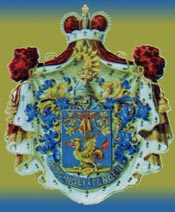
The House of Dadiani
In reward for military services to the Kingdom of Georgia, the Dadianis were given the hereditary title of eristavi (Duke) of Odishi (as Samegrelo was known in the Middle Ages and early modern era). The lineage extends back to Konstantin Dadiani, who worked for the government of the Kingdom of Georgia from about 1140 to 1180, and possessed the title of msakurtukutsesi. The msakurtukutsesi was the major-domo of the royal court—the manager of the court’s household and finances. Konstantin also served as minister of treasury and finance.
 |
After Konstantin, several other Dadianis rose to prominence in the court of the Kingdom of Georgia. For example, Konstantin’s son Vardan was minister of transportation (1178-1184) and, like his father, minister of treasury and finance (1184-1191). And in the second half of the 13th century, Bedian I Dadiani was an influential minister of defense. By that time, the Dadianis had become the most powerful feudal house in western Georgia.
After the break-up of the united Kingdom of Georgia in the 15th century, Odishi became a part of the Kingdom of Imereti, and the Dadianis began a long struggle to gain the title of mtavari (Principal). This created an obvious conflict with the Kings of Imereti, because a Principal’s powers were, for all intents and purposes, the same as those of a King.
It was not until the middle of the 16th century that Levan I Dadiani was formally recognized by the Ottoman Empire, which dominated western Georgia at the time, as Principal of Odishi, thus making Odishi independent of the Kingdom of Imereti. For centuries afterward—until both Imereti and Odishi were swallowed up by the Russian Empire in the 19th century—the Kings of Imereti intermittently sought to regain control over Odishi through intrigue or force. However, they were never successful.
Indeed, during the reign of Levan II Dadiani (1611-1657), the Principality’s power grew to the point where the tables were turned, and Imereti narrowed escaped military subjugation to Odishi on several occasions. Externally, Levan II enjoyed a status equal to that of the Kings of the Georgian Kingdoms of Kartli, Kakheti, and Imereti. In one letter to the Tsar of Russia, he even referred to himself as the King of Western Georgia, even though neither he nor any of his successors had any formal grounds for claiming the title of “King.”
On January 4, 1867, the Russian Empire officially eliminated the Principality of Samegrelo, incorporating it into the Empire as an integral part. The Dadianis kept their palaces and lands, along with honorary (if somewhat meaningless) titles such as “Your Serenity.” The Empire granted the last Principal, Nikolas Dadiani, the hereditary title of Prince Mingrelski, which preserved his status among the nobility without conferring any real power.
[ TOP ]
